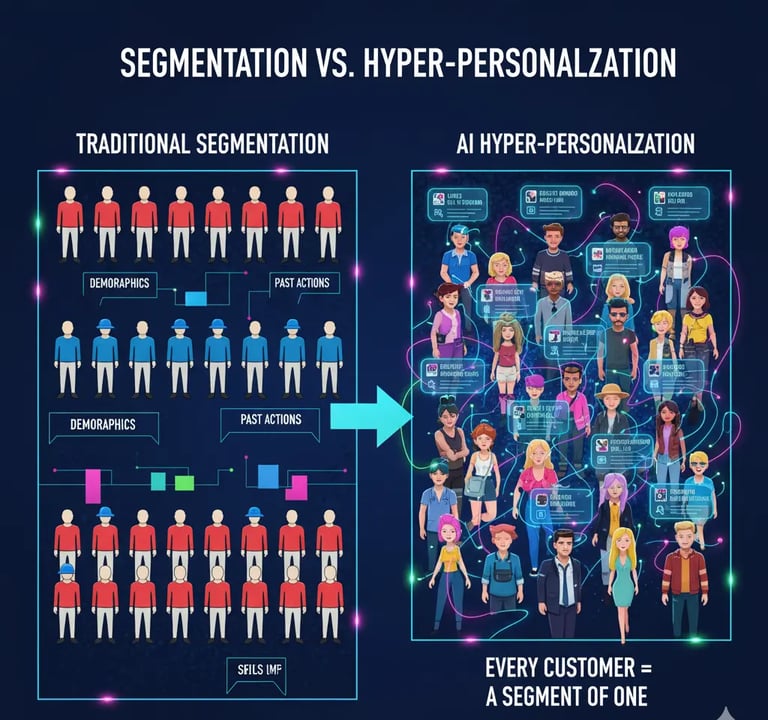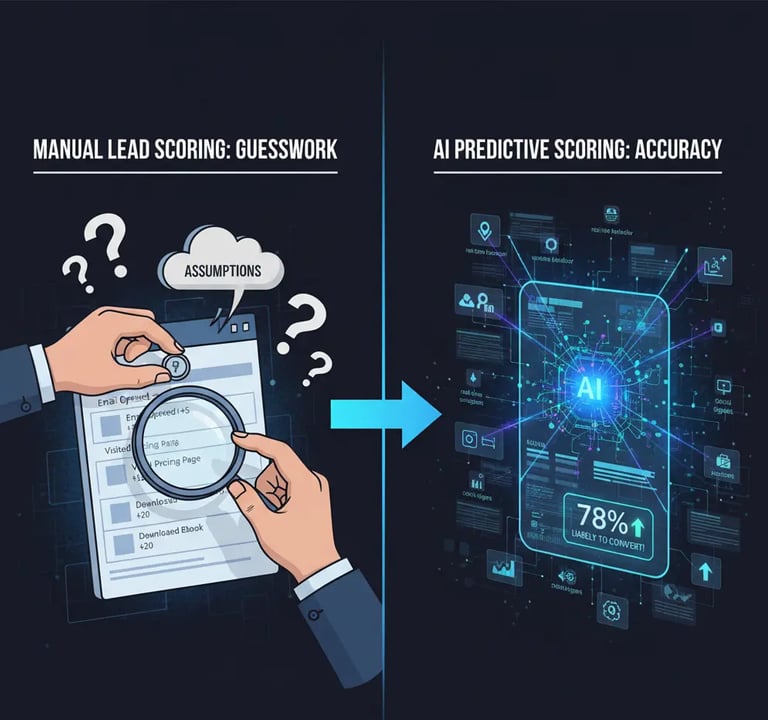AI vs. Traditional Automation: Where to Upgrade Your Marketing Stack
10/28/20254 min read

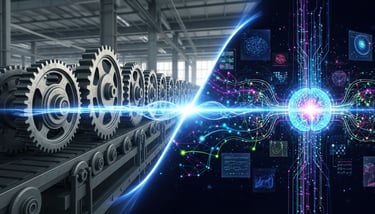
Your marketing automation isn’t broken — it’s just outdated.
Most companies still rely on rule-based workflows built for another era. “If this, then that” logic worked when customer journeys were linear. But in 2025, buyers move across devices, channels, and decisions faster than most systems can follow.
So, the real question is:
Is your marketing stack built for execution — or for intelligence?
From Efficiency Engines to Intelligent Systems
Traditional marketing automation was designed for efficiency.
It’s the reliable assembly line of marketing: executing email drips, nurturing leads, and scheduling campaigns at scale. Structured and predictable — but not adaptive.
Artificial Intelligence, on the other hand, represents the brain of modern marketing.
It doesn’t just automate what you do — it transforms how you do it. AI learns, predicts, and optimizes in real time, turning static workflows into intelligent growth engines.
Think of automation as the muscle that powers action, and AI as the brain that drives direction.
One scales output. The other scales intelligence.
Execution vs. Intelligence: The Core Divide
Automation follows rules.
AI makes decisions.
Automation says, “If a user downloads an ebook, send a thank-you email.”
AI says, “This user is 70% likely to convert — send them a demo invite instead.”
That’s the shift: from following instructions to understanding intent.
Automation performs the tasks you define.
AI identifies what matters most — and continuously learns from every result.
Where to Upgrade: 5 High-Impact Areas
You don’t need to rebuild your stack from scratch.
You just need to upgrade the systems where AI delivers exponential ROI.
1. From Segmentation to Hyper-Personalization
Traditional automation groups audiences by demographics or past actions.
AI treats every customer as a “segment of one.”
It analyzes real-time behavior, timing, and context to deliver hyper-personalized recommendations, improving engagement and conversions across the funnel.
📊 According to McKinsey, 71% of consumers expect personalized experiences, and AI-powered personalization can lift conversions by up to 30%.
2. From Points to Predictions in Lead Scoring
Manual lead scoring is guesswork. Marketers assign arbitrary points to actions like “email opened” or “visited pricing page.”
AI replaces assumptions with accuracy.
Machine learning models evaluate thousands of signals to predict which leads are most likely to buy – increasing conversion rates and shortening sales cycles.
📈 Grammarly used AI lead scoring to boost premium conversions by 80%.
3. From Reporting to Real-Time Intelligence
Traditional dashboards tell you what happened.
AI analytics tell you what’s happening next — and what to do about it.
AI systems detect anomalies, forecast campaign performance, and recommend actions in real time.
Instead of reacting to reports, marketers can proactively optimize campaigns mid-flight.

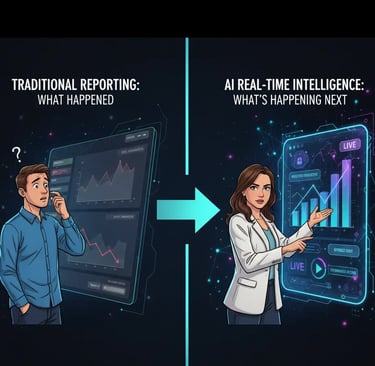
4. From Templates to Dynamic Creation
Legacy automation relies on pre-set templates.
AI brings creativity and adaptability through Generative Content and Dynamic Creative Optimization (DCO) — testing hundreds of ad variations in real time and automatically deploying the best-performing ones.
🎨 Telenor used DCO to triple its social media ROAS.
Result: faster production, smarter testing, and higher-performing campaigns.

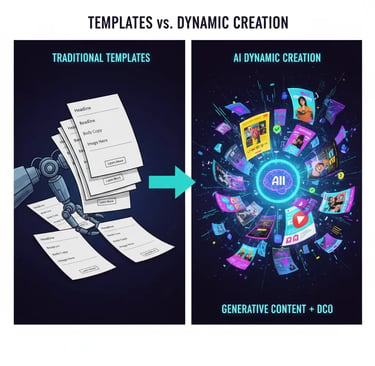
5. From Manual to Predictive Systems
AI is transforming every layer of the marketing stack:
CRM: From static data to predictive forecasting and next-best-action insights.
Email: From generic drips to send-time optimization and churn prediction.
Advertising: From manual bidding to real-time audience discovery.
Across the board, the shift is from managing processes to managing intelligence.
For growing B2B teams struggling with disconnected workflows and inconsistent lead flow, this is exactly where BriskFab makes a measurable difference — integrating data, automating personalization, and driving intelligent lead conversions at scale.
The ROI of an AI Upgrade
AI is not just a technology shift — it’s a performance multiplier.
12–28% reduction in marketing overhead.
5+ hours saved weekly per marketer.
5–15% increase in marketing-driven revenue.
6x higher transaction rates from AI-personalized emails.
(Source: Statista, PwC)
AI doesn’t just make marketing faster – it makes it smarter, cheaper, and more profitable
How to Know If You’re Ready
AI adoption isn’t a flip of a switch – it’s a staged evolution.
Before upgrading, assess readiness across four pillars:
Strategy: Do you have clear, measurable goals (e.g., “Reduce CAC by 15% in two quarters”)?
Data: Is your customer data clean, centralized, and accessible?
Technology: Is your MarTech stack API-friendly and AI-compatible?
People: Does your team have the skills and mindset for data-driven decision-making?
If your data or culture isn’t mature yet, refining traditional automation first will set the stage for a smoother AI transition.
The Future Is Hybrid — Not Either/Or
The future of marketing isn’t automation versus AI.
It’s automation and AI — working in tandem.
Automation ensures reliability and scale.
AI brings agility and intelligence.
Together, they transform marketers from executors into strategic orchestrators — managing intelligent systems that learn and adapt continuously.
And the next leap is already here: Agentic AI, where autonomous agents manage entire campaigns toward defined outcomes.
Gartner predicts that by 2026, 40% of enterprise apps will feature these intelligent agents.
The Takeaway
Traditional automation gave marketers efficiency.
AI brings intelligence.
And the organizations that master both will define the next era of growth.
If your marketing stack still runs on static rules while your customers act on dynamic intent — it’s time to evolve.
That’s where BriskFab can help – integrating intelligence into your systems, streamlining workflows, and turning every campaign into a learning engine.
Start small. Prove ROI. Then scale fast.
Because in the age of intelligent marketing, the smartest stack always wins.

